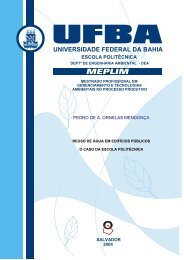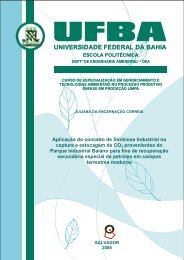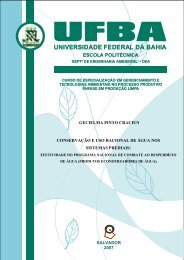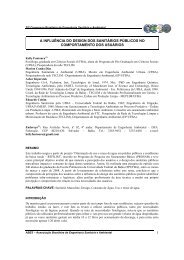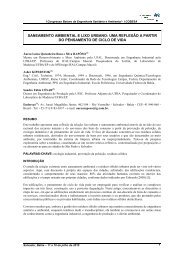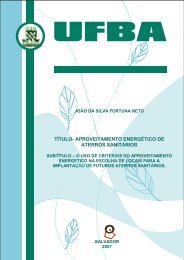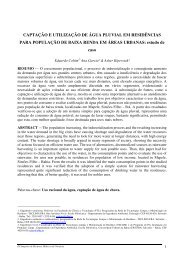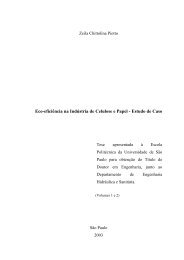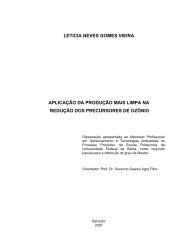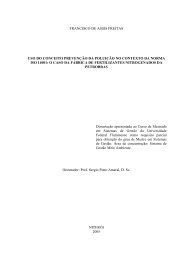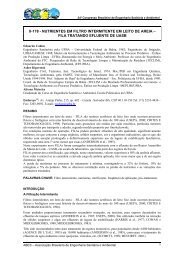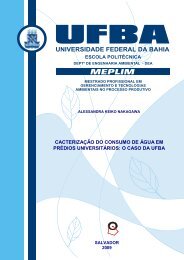Aplicação do conceito de Produção Mais Limpa na ... - TECLIM
Aplicação do conceito de Produção Mais Limpa na ... - TECLIM
Aplicação do conceito de Produção Mais Limpa na ... - TECLIM
Create successful ePaper yourself
Turn your PDF publications into a flip-book with our unique Google optimized e-Paper software.
<strong>Aplicação</strong> <strong>do</strong> <strong>conceito</strong> <strong>de</strong> <strong>Produção</strong> <strong>Mais</strong> <strong>Limpa</strong> <strong>na</strong> otimização <strong>do</strong> processo <strong>de</strong> produção <strong>de</strong> Álcool Butílico<br />
ABSTRACT<br />
The object of this treatise is to <strong>de</strong>scribe a typical industrial problem occurred<br />
in a butilic alcohol production plant. Historically, production was carried out<br />
to specifications a<strong>de</strong>quate to the needs of the client. A new client came up<br />
with a much higher <strong>de</strong>gree of requirement for specifications of the product.<br />
At first, the company solved the problem by repurifying the product. The<br />
client was entirely satisfied with this solution but production costs increased<br />
not to mention an additio<strong>na</strong>l generation of ema<strong>na</strong>tions with a high organic<br />
load. The company was already preparing itself for an improvement project<br />
with investments in wi<strong>de</strong>ning of purifying columns when it started to a<strong>do</strong>pt a<br />
preventive attitu<strong>de</strong> utilizing Cleaner Production concepts. It was found<br />
through <strong>do</strong>cumentary research (primary source) and old technical registers<br />
that a test was carried out by the owner of the technology (with a promoter<br />
on a pilot scale). This promoter inhibited the formation of secondary<br />
reactions. Based on these results, the company carried out tests on an<br />
industrial scale, that is to pay, it moved precisely towards a change in the<br />
process, aimed at reducing to a minimum un<strong>de</strong>sirable secondary reactions<br />
in the reactor and as a consequence a reduction of the organic load in<br />
ema<strong>na</strong>tions. The work is supported by concepts in Pollution Control,<br />
Pollution Prevention, Clean Production and Cleaner Production. Corrective<br />
approaches and preventive strategies are examined. The main pipe-end and<br />
prevention techniques are also consi<strong>de</strong>red. Environmental strategies and<br />
their characteristics are estimated. For a better un<strong>de</strong>rstanding of the<br />
problem and its solution, state-of-the art production of oxo-alcohols is<br />
discussed with a focus on the process and the reaction that was optimized.<br />
The work shows results obtained in the study of the application of cleaner<br />
production concepts in process optimization. Prevailing traditio<strong>na</strong>l<br />
ma<strong>na</strong>gement aspects are shown as well as environmental and economic<br />
advantages through a prevention logic. This study comes to the conclusion<br />
that old production ma<strong>na</strong>gement paradigms no longer have any support in<br />
the face of the prevention logics of cleaner production.<br />
Key words: Industrial Pollution; Cleaner Production; Clean Technologies;<br />
Optimization Process; Butanol Production.<br />
TAKAYOSHI OGATA



